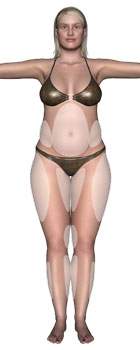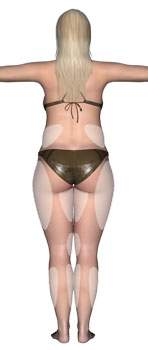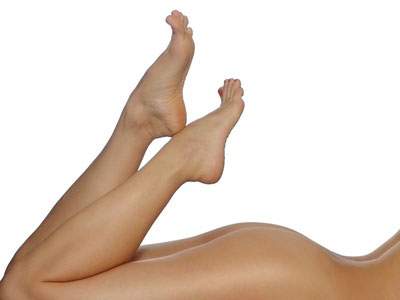Liposuction is a proven and established procedure to reduce fatty tissue. Today it is one of the most frequently performed operations in plastic surgery.
Many people find problem areas on their own body. Very often, these are fat deposits in typical areas that can prove to be extremely hard to handle in the face of dieting and exercise.
Therefore, the desire for liposuction is often aroused.
In women, these fat pads typically appear on the outer thighs as riding breeches. The inner knees and inner thighs are also often affected.
In men, the hip regions are often affected, which are known as “love handles”.
A major cause of suffering in men is the accumulation of fat in the breast area, gynaecomastia, which greatly affects the male appearance.
At the Yuveo Clinic Düsseldorf, we are able to normalise the individual appearance of our patients in many cases and thus optimise the aesthetics of the proportions by liposuction.
Inhalt
Yuveo Klinik
Special features of liposuction
The scope of the liposuction can range from a small procedure under local anaesthesia to mega fat treatment of more than 10 litres, e.g. in lipedema.
Liposuction
Vibration assisted liposuction
Body areas
Liposuction - the treatment
Liposuction can be performed under local anaesthesia with or without twilight sleep, depending on the estimated amount of suction.
For larger volumes, serious consideration should be given to general anaesthesia, which can be beneficial for both the patient and the plastic surgeon.
In the case of liposuction of large volumes (more than 4 l) or in the case of certain secondary diseases, a short in-patient stay is advisable.
The duration time to be calculated ranges from 45 minutes to about 3 hours.
Before the liposuction, we mark the regions to be worked on with the patient standing.
In the abdominal area, we scan the abdominal wall for hernias (umbilical hernia, inguinal hernia, …) to avoid injury to such a hernia, which may also contain intestine.
Administering the tumescent fluid
In the course of treatment we inject a special saline solution called tumescent solution into the marked areas.
When doing this, we place the punctures in inconspicuous areas.
Mega liposuction can involve amounts of fluid in excess of 5 litres. The pre-warmed saline solution usually contains one or two painkillers and a substance that causes the small vessels to contract, reducing the risk of bleeding.
Exposure to the fat-dissolving fluid
After infiltration, the tumescent solution should be left to work for at least 20 minutes to facilitate liposuction.
During this time, the fat cells swell and become very susceptible to mechanical stress due to the increased tension of the cell membranes.
This means that more fat can be extracted with less mechanical stress and the surrounding tissue (nerves, vessels, abdominal wall, …) is spared.
The actual liposuction begins after the exposure time is over.
Suction of the fat
The fat is now extracted through the above-mentioned puncture points by even movements with special cannulas for liposuction. This is done using a suction system that continuously builds up negative pressure.
The suction cannulas are adapted to the size and shape of the operation.
Modern systems such as PAL (vibration assisted liposuction) make the liposuction procedure more effective and gentle with the help of vibrating cannulas.
In the illustrations you can see the areas most frequently treated during liposuction.


Frequently asked questions about liposuction
Is it possible for new fat cells to form after liposuction?
To put it in a nutshell: “WHAT HAS BEEN SUCKED AWAY WILL NOT COME BACK!”
The fat cells that have been destroyed or removed by liposuction will not come back.
In adults, fat cells cannot reform, or at most only to a very small extent. There is also no evidence that the fat will multiply in other parts of the body. This is a general increase in weight.
Of course, the weight gain cannot be seen in the areas where the liposuction was performed, because there are significantly fewer fat cells than before the operation.
However, the remaining fat cells will store the fat in the usual way. This means that the proportions remain the same after liposuction.
In the case of abdominal liposuction, this would mean that if you gain weight after the operation, the abdomen will remain proportionally smaller.
What role does skin quality play in liposuction?
During the consultation we also pay special attention to skin quality with regard to liposuction.
Young patients
In young patients with good skin quality (no sun-damaged skin, no cellulite), it can be assumed that the shrinkage tendency of the skin is just as good, even with a large amount of suction.
Elderly patients
Despite all considerations, in the case of severely sagging, older and sun-damaged skin, with larger suction quantities, there are clear limits to skin shrinkage that cannot be eliminated even by liposuction using UAL and PAL.
In these cases, we will at least discuss with you the possibility of a skin tightening operation that will be necessary later.
Two-layer fatty tissue
Fatty tissue has a two-layer structure in almost all parts of the body, which we take into account during liposuction.
The deep fat layer with large fat cells is located under a firm fibrous layer = Scarpa’s fascia.
The superficial fat layer is a collection of finer fat cells above Scarpa’s fascia. Both layers are included. In this way, a significant improvement in skin shrinkage can also be achieved.
Why is liposuction with vibration (PAL) beneficial?
PAL is a vibration-assisted liposuction procedure. The system produces a fine cannula vibration via a special handpiece. The tumescent solution is also used here, with an exposure time of about 20 minutes.
The vibration achieves a similar effect as with ultrasound-assisted liposuction (= UAL). The swollen fat cells can be destroyed more easily and removed more gently.
With PAL there is no heat effect, which can lead to burns with UAL.
Because of this decisive advantage, vibration-assisted liposuction is becoming increasingly popular.
At the Yuveo Klinik in Düsseldorf we can achieve a skin shrinking effect through appropriate processing of the superficial fat layer by using PAL.
What is special about sweat gland removal?
Initially, sweat gland removal was performed using a technique similar to liposuction.
However, lipocurettage allows for the successful treatment of excessive sweating in the armpit.
The technique goes one step further than mere sweat gland suction.
In contrast to the therapy with Bttx, lipocurettage is not a method with temporary success.
How is the aftercare carried out?
After liposuction, small plasters are applied to the injection sites and compression garments (waistcoat, trousers, sleeves, etc.) must be worn. Sometimes the puncture sites are also sewn up with stitches.
However, if these areas are completely sealed, the wound water cannot escape from the body.
Especially during the first night, a lot of fluid is discharged through the small puncture sites. The need for painkillers after liposuction is moderate. Most patients only report severe muscle ache.
Drains
Drains are an exception.
Compression
Especially in the first 24 hours after liposuction it is important to stay calm to prevent bleeding of the small injured vessels. In the first days / weeks, swelling and bruising (even sideways) of the skin are normal. These are reduced by wearing appropriate, if necessary, custom-made compression garments.
Swelling
Post-operative swelling is present after treatment. It may be more pronounced due to minor bruising or wound water effusion. Some hardening is also normal postoperatively.
These changes improve noticeably in the first few weeks after the operation. During this phase, compression garments are strongly recommended and should be worn for 6 weeks.
However, slight to moderate swelling may still be visible afterwards.
Sutures
We use stitches in part to allow the puncture sites to heal as inconspicuously as possible. They can be removed after 5-7 days.
Wound effusions (seromas)
Relatively large wound areas develop, even if only very small punctures are visible externally. These wound areas can produce wound water depending on the individual tendency.
Sometimes smaller and medium-sized seromas (= wound water effusions) develop, which dissolve themselves over time.
Sometimes we have to puncture the larger wound water effusions with a cannula.
Showering
Showering is allowed after 2-5 days. Before that, the puncture sites must remain dry.
Skin feeling
The skin feeling can be reduced in the medium term after liposuction. Permanent loss of sensation is rare.
Sport
After medium and large liposuction, sports that cause movement in the suctioned areas and/or are strenuous should be avoided for 5-6 weeks.
If special regions such as the face, calves, ankles and other unusual areas are suctioned, we must adapt the aftercare to the requirements of these regions.
What are the costs of liposuction?
The prices for liposuction can vary greatly. The following influencing factors play a role:
- extent of the liposuction
- duration of the stay in the clinic
- prices for anaesthesia or sedation (twilight sleep)
- fee of the plastic surgeon
Note: Some plastic surgeons have specific prices for predefined regions that are suctioned. Others calculate with the amount of fat that is removed.
Overview
Below we give you an overview in relation to the amount suctioned:
– Liposuction mini (e.g. double chin)
– Up to 1 litre
– For 1-3 litres
– Over 3 litres
The anaesthetic fee is added. For a small liposuction, sedation (twilight sleep) is sometimes sufficient. If very small regions are treated, local anaesthesia is sometimes sufficient. Some clinics also charge a fee per day for an inpatient stay.
In so-called mega liposuction procedures, which are related to lipedema, up to more than 10 litres are suctioned out.
The prices, including anaesthesia, are usually quite high. Generally, costs can be reduced if larger amounts are removed in one session. An in-patient stay is mandatory for such operations.
For further details and more exact prices, please ask our team of plastic surgeons in Düsseldorf.
Checking the facts
- Surgeons: Dr. Schumann and Dr. Schumann-Averkiou
- Treatment duration: depending on the extent of the treatment: 45 min. to 3 hours
- Anaesthesia: local anaesthesia, twilight sleep, general anaesthesia
- Hospital stay: outpatient or inpatient
- Aftercare: compression garment for 6 weeks, rest
- Stitches removed: after about 5 to 7 days
- Sport: Avoid sport for 5 to 6 weeks.
- Costs: Prices depend on the amount of suction, plus anaesthesia or general anaesthesia and hospital stay.
Further information and related topics
Technical terms
– Liposuction = method to reduce fatty tissue
– Lipedema = fat distribution disorder
– PAL = power-assisted liposuction, favoured suction technique
– Tumescent solution = special saline solution with a local anaesthetic and an agent to constrict the blood vessels. It is injected into the fatty tissue and leads to the dissolution of the fat cells.

